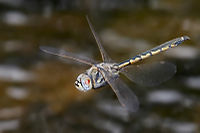
Photo from wikipedia
The evolution of unsteady vortex structures in the tip region of an axial compressor rotor is investigated based on delayed detached eddy simulation. The vortex structures are identified by the… Click to show full abstract
The evolution of unsteady vortex structures in the tip region of an axial compressor rotor is investigated based on delayed detached eddy simulation. The vortex structures are identified by the [Formula: see text] method, and the velocity fields are visualized by the particle tracing method. The results show that the evolution of the tip leakage vortex (TLV) can be divided into three phases: the generation phase, the development phase, and the dissipation phase. The unsteadiness of the flow field mainly appears in the dissipation phase as a consequence of the unsteady secondary tip leakage. There are three primary unsteady vortex structures caused by the tip leakage flow (TLF), and these vortex structures are related to each other as a feedback loop. The intermittent formation of the vortex ropes leads to the breakdown of the TLV and thus results in the roll-up of the backflow vortex (BFV) due to the radial velocity gradient. The secondary leakage of the BFV locally enhances the TLF jet and affects the formation of the vortex ropes in turn. This feedback loop causes the unsteady behavior of the TLF and has great impacts on the performance and stability of the compressors.
Journal Title: Physics of Fluids
Year Published: 2023
Link to full text (if available)
Share on Social Media: Sign Up to like & get
recommendations!